I first designed and produced ready-made pond filters back in 1978, the only others available back then were the converted loft header tanks.
(These are still on sale today at most garden centre outlets – they don’t work at all – but they are cheap and still remain to be the top sellers of all time!)
Here now is a compilation of Waddy’s ‘ Filtration Hits and Misses’ since 1978 to date – be assured, there are far more misses than hits.
1978 saw the launch of this beauty –

These were made from polypropylene tubes and pump-fed from the pond. Water was pumped into the base of these and around halfway up the tube I placed a 9” deep bed of Canterbury Spar gravel on a support tray. The water passed up through the bed to the top of the unit where it was taken to the outlet and returned to the pond by gravity.
The bottom of the gravel bed caught most of the pond debris as expected, but I soon detected the return water was slowing down.
Of course the system needed stopping and the gravel needed cleaning – all too often – and biological activity was nil – chalk this up as a MISS!
………………………………………………………………………………………
Also in 1978 I designed and produced the first multi-chamber (rise and fall) filter ever heard of and felt extremely smug with myself.

Again, the filter media was Canterbury Spar gravel also held off the base by perforated PVC support trays.
Sad to say, the gravel clogged up, the chambers produced head loss and pumps almost ground to a halt.
Thus followed laborious cleaning, far too often for my liking – yet another MISS!
………………………………………………………………………………………………..
Waddy then fell out with filters for a while and concentrated his attentions to designing and producing the very first bottom drains ever seen!
Back then, the most expensive part of garden pond design was the butyl liner and when Waddy they would need to cut 10” diameter holes to accommodate my drains – the consensus came back that Waddy was completely barmy!
However, Waddy was made of much sterner stuff and started to carve up his own butyl liner – gingerly.
Thankfully the installation was a success although I didn’t actually sell one until 1981 to a guy named George Hurst.


Soon after, the floodgates opened and later found myself selling as many or more bottom drains than the number of individual pellets inside a 15k sack of Hikari Wheatgerm!
This was my first HIT – and a massive one at that!
Of course the copiers latched on to these and soon started making smaller, nastier and cheaper versions…………
………………………………………………………………………………………………..
In 1982 I once more picked up the sword in my quest for perfect pond filtration and out flowed these sterling designs – the very first to be made in glass fibre!

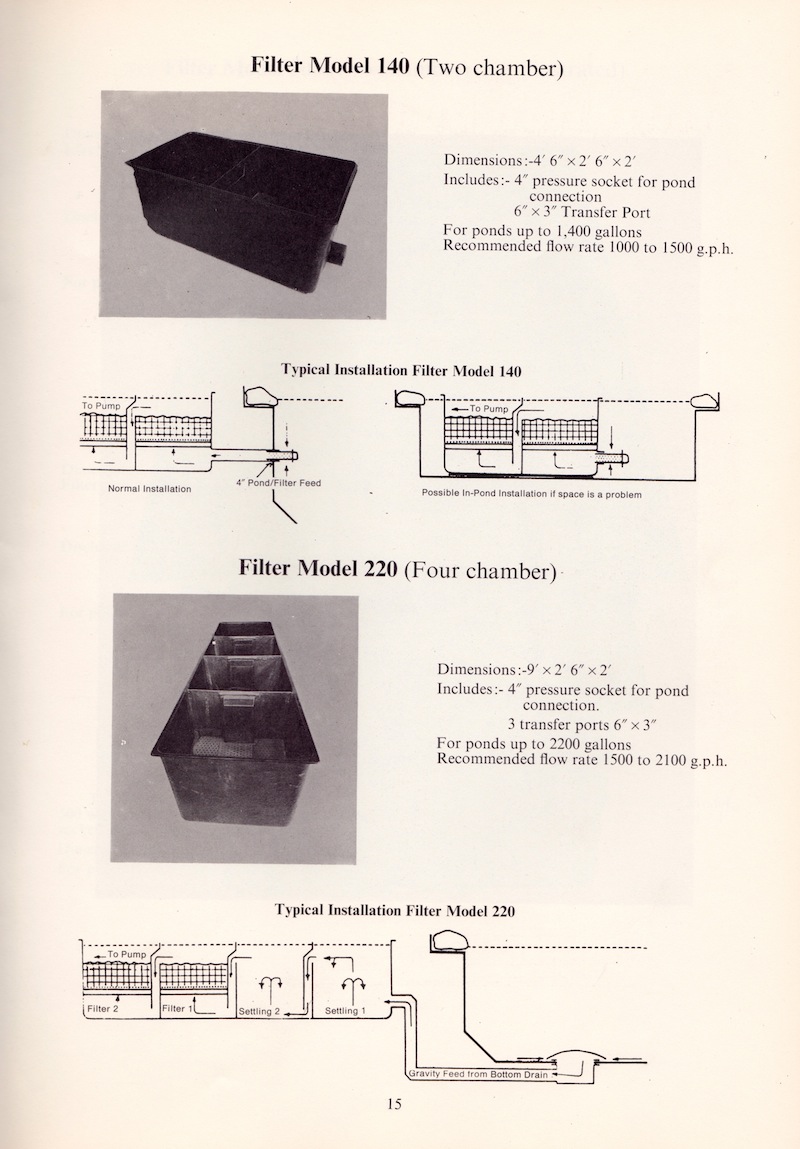
And I’d like to be able to report that after the Koi World of the day actually saw these innovations – they all fell to their knees and called out simultaneously – ‘Arise Sir Waddy – you’re a true genius’!
Like I say, I’d like to report it but it did not happen……….
Clogging occurred again and I had to write that one off as a MISS!
………………………………………………………………………………………………..
Did all this put Waddy off his goal?
YES – sorry I meant to say ‘NO’ because I had already considered that if I made filters with much larger chambers then the cleaning process would not arise as often?????
So I launched my cunning plans with this giant of a design –

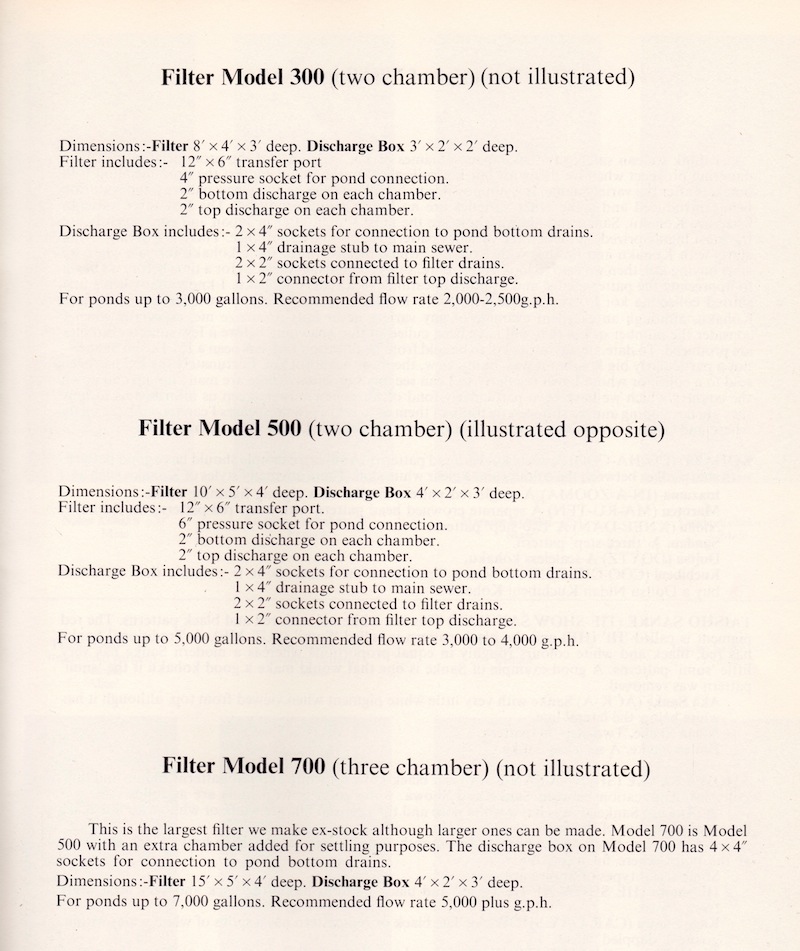
Huge units complete with their own discharge box for the pond drains and the filter drains and each one stopped by a standpipe!
And then – wait for it – the discharge box was – yes you guessed – connected to the sewer!!!
Yet another stroke of pure genius from yours truly?
Sorry, despite the fact that these all had to be positioned in place by fork-lift trucks and also produced many hernia problems – they failed.
The only areas in these huge boxes where mechanical filtration took place was where the water entered and exited the gravel right next to the transfer port and that’s when I first detected ‘tracking’.
Yet another famous MISS of mine folks!
…………………………………………………………………………………………….
Hmmmm, thought I to myself ….. could it be the shape of the boxes that produce so much tracking and zero biological filtration?
And that’s when the penny dropped and said to myself – ‘The shape MUST be changed’!
(I did talk to myself often in those days.)
So, in 1984 – out came the ‘800 range’ – complete with octagonal boxes and a cute new method of water transfer –

After the launch of this wonder I began to consider what to do with the untold millions that would be sure to arrive into my coffers.
Sadly it never did as the same ‘tracking’ problems remained – so here is another MISS.
…………………………………………………………………………………………….
Things went a bit downhill from there and I often took refuge in a pint or five at my local hostelry.
I gazed down at my circular glass and wondered how ale would taste had it passed through filthy gravel first – and also how heavy the glass would be had I to lift it?
The circular shape of the glass became a constant nag but the thought of an entire container load of sofa-stuffing material from Japan did not seem to be the enormous waste of money as I first thought –
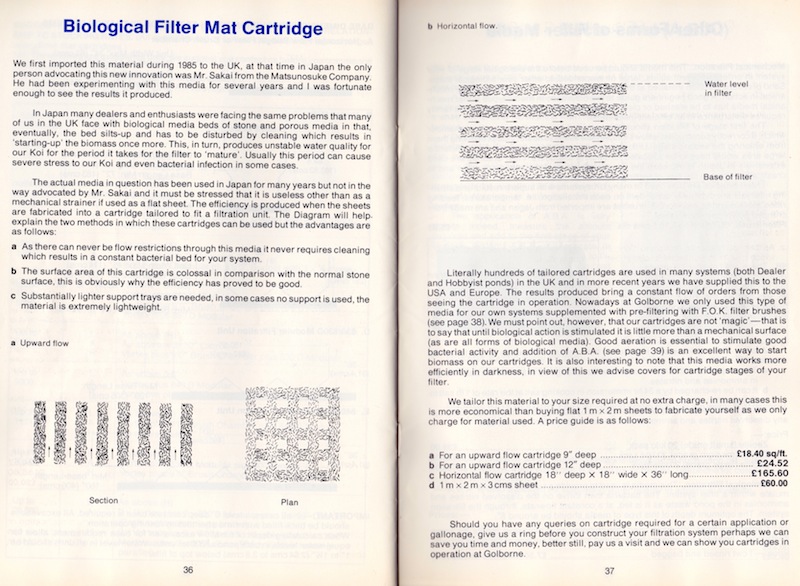
Although I had witnessed this stuff in Japan – I still had no name for it, but if this stuff could replace the heavy gravels only available then – then surely this would be a breakthrough!
I still didn’t believe that biological filtration could be achieved by passing water through a series of open holes but face it, the customers would believe anything – especially if the info had come from a Koi dealer!
The stuff arrived in late 1984 together with this mechanical gear –
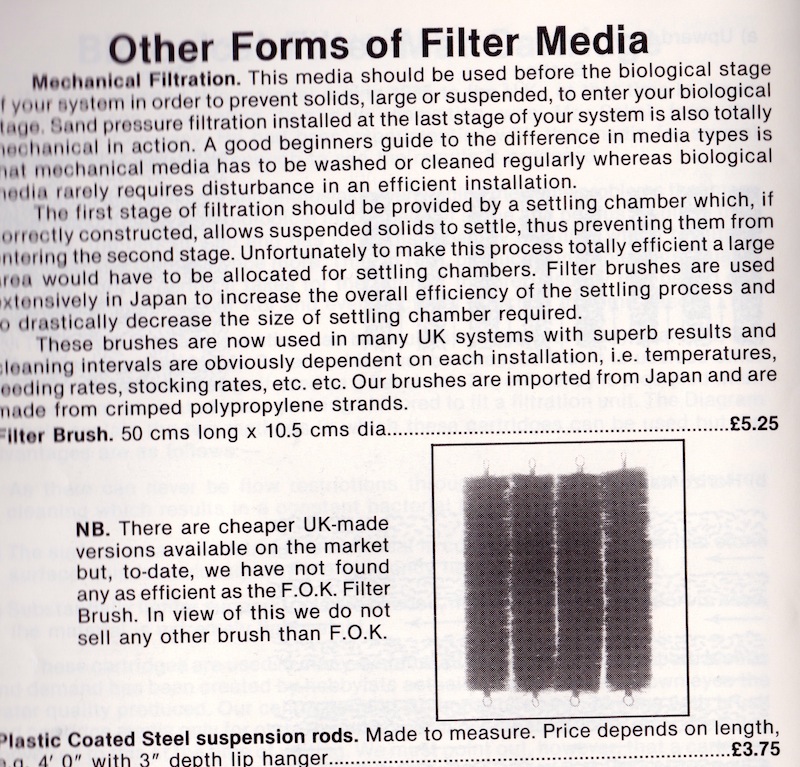
And a load of high output air pumps to complete the perfect triumvirate!
I’m sure you will all agree this has to be a triple HIT?
…………………………………………………………………………………………..
Now, back to the circular shape of my glass – why not make a circular-shaped filter box?
That has to be worth a try hasn’t it, certainly in terms of strength it has to be the strongest?
So in 1985 – I invented and produced the first circular filter box and named it ‘The Vortex’!
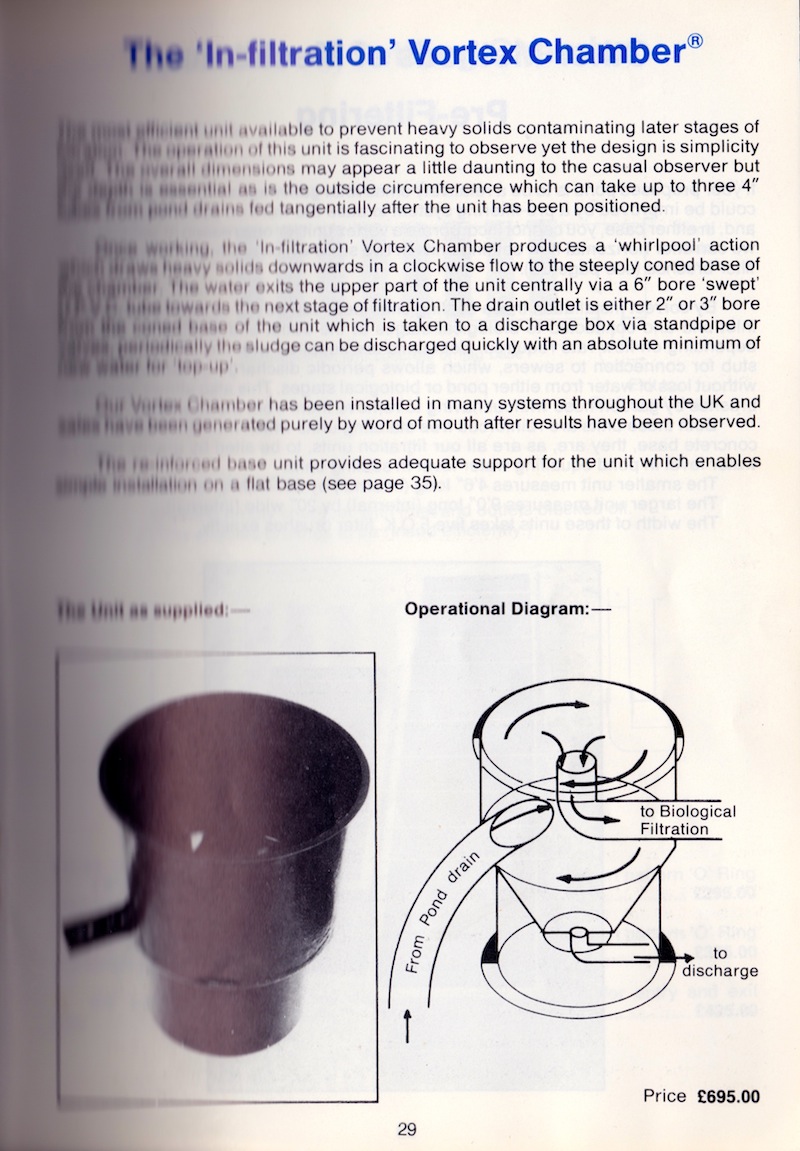
I must confess when others saw this for the first time, they poked fun at me and some openly pissed themselves.
But my idea behind it all was to link drains to this large-diameter unit and give a gentle flow in the hope that heavy solids would be taken to the cone-shaped base by centripetal action where they could then be discharged – simply a perfect mechanical stage.
Of course, by then the copiers had decided that the Vortex was a winner and so – just like the brainless always do, decided to make their own – smaller, nastier and cheaper.
After a few months there were Vortex units out there spinning faster than a car wheel at 150mph!
I tested the first Vortex unit on my main pond at Infiltration and checked the base daily. It look OK to me in terms of collecting the pond waste so I decided to see how circular chambers containing tailored Japanese filter cartridges would work as biological stages and thus arrived this that was first shown in my book ‘Koi Kichi’ in 1995 –

This same system ran my main pond at Infiltration for some 16 years but I soon realised how little the water flow was to the biological surfaces – noting the water only contacted the central outlets on the units whilst the remainder just collected dust.
The other problem here was, the Vortex needed a very slow flow rate but the biological chambers needed twice the amount and with one single water pump, this is a problem.
Another MISS.
………………………………………………………………………………………………
In 1992 I came up with this design – not for a filter system but the only way I know we can all be sure that our bottom drain lines are supplying equal amounts of water to any filter system.
‘One drain to one filter to one pump’ is the only way this can be achieved!

Surely this has to be a HIT?
………………………………………………………………………………….
I really do not know why I decided to include this next design in ‘Koi Kichi’ – probably to appeal to those enthusiasts that were not flushed with money?
I still don’t know, but the truth is – I did.
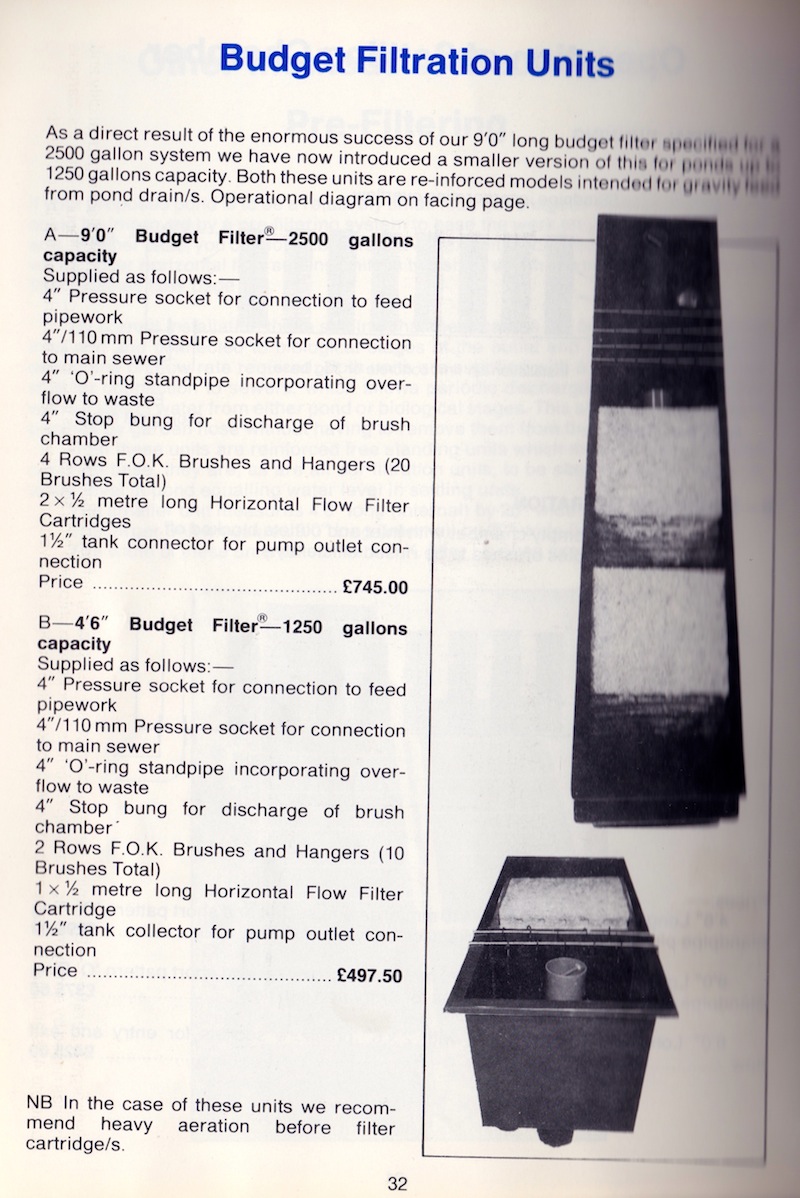
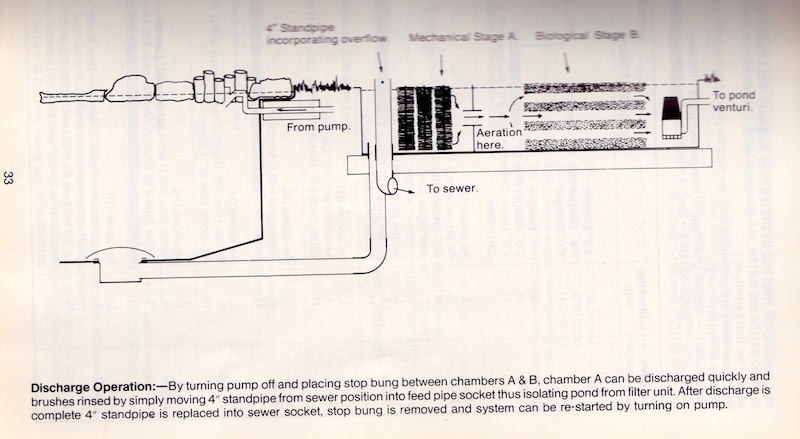
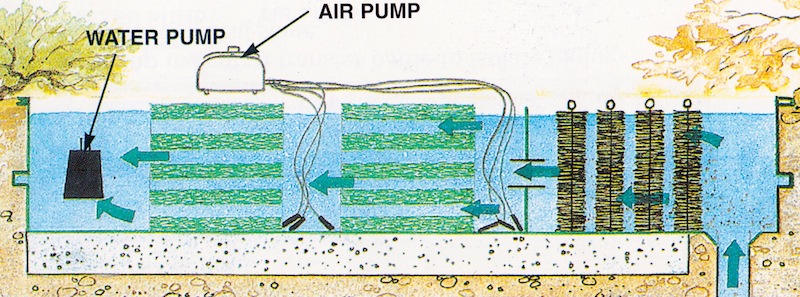
I sold many of these filters from 1986 to 2002 when I decided to concentrate much more on Koi than dry goods.
I cannot recall the numbers sold but I do recall I never received one single complaint about them and also know of several still running today!
Another sure-fire HIT because this filter turned out to be the forerunner of my Eric Filter Systems as they are today.

Another HIT?
………………………………………………………………………………………..
Yes, it has been a long road but I’m still enjoying the journey.
Waddy 20/03/15
